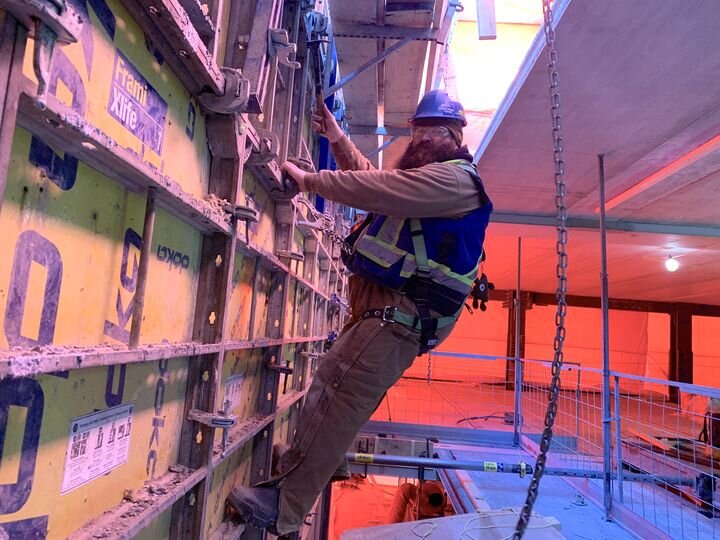![Working on a concrete project [Source: Morgan Fiks]](https://fabbaloo.com/wp-content/uploads/2020/05/morgan-construction_img_5eb050b28eaa5.jpg)
With all the recent controversy over construction 3D printing, I thought it a good idea to ask an actual, real-life construction worker how they felt about the concept.
Contrary to the hype-loaded headlines, construction 3D printing is not capable of “3D printing a house in 24 hours”. It seems unscrupulous entrepreneurs and media conspire to publish these false stories every month, causing plenty of misconceptions about the tech.
The truth is that there are construction 3D printers, but they merely extrude concrete. That’s an important part of many building projects, but hardly the ability to complete an entire, functioning building. One way to look at it is that these homes are built in a totally traditional manner, EXCEPT that some of their concrete was 3D printed.
Waving aside the extreme hype, I sought answers to whether this technology might actually be welcomed by real construction workers who perform concrete work. I asked a tradesman acquaintance, Morgan Fiks, of his opinion on the technology.
I should point out that Fiks is a very forward-looking young person in the construction industry who normally welcomes new concepts.
Fabbaloo: Do people in the construction industry have any awareness of 3D printing, and in particular construction 3D printing?
Morgan Fiks: I can only really speak to the company I work for and I know for a fact they know about 3D printing because I’ve printed a crane in company colours that lives at our head office and countless battery clips that are scattered across our job sites. In terms of construction 3D printing specifically these concrete printing machines I really don’t believe these will ever have much viability in any climate that reaches below zero Celsius.
Fabbaloo: What types of projects do you believe might benefit from a construction 3D printer onsite, able to deposit concrete?
Morgan Fiks: Placing concrete in modern construction is often done using a pump truck, that is a truck that has a hopper in the back to accept cement from another truck and an articulating arm outlet. Cement, with all its beautiful aggregates and additives is also really heavy and often coming out of the business end of these pump trucks it can be pretty violent especially if an air bubble occurs.
Watching some of these ‘3D print a home’ videos seems like a fantasy in the way their perfectly consistent “pudding like” building material extrudes with such precision and perfection, not a drop spilled. The generally accepted method is to build reinforced forms from plywood and lumber to withstand the pressure of thousands of cubic feet of liquid cement and then strip it all off in a couple days once it’s cured and ship it off to the next job to be reused. It’s extremely labour intensive, you show me a robot that can make the forms to pour the grade beams to a 50,000 square foot building in a day and I’ll call that a billion dollar idea.
Fabbaloo: Where would decisions have to be made in order to leverage construction 3D printing in a beneficial way? Would the construction team be able to, or is it really something decided way back when the project is designed?
Morgan Fiks: I think when you have a really labour heavy method of building along with it being costly safety is always an issue. In today’s industry the bottom line and worker safety is always considered on bids and held in equal importance. Any contractors that can deploy automated methods like 3D printing will have an advantage In the near future if not now as long as it is both cheaper and safer.
Fabbaloo: You build structures in all types of weather; do you feel construction 3D printing could be used in different weather scenarios?
Morgan Fiks: In the methods I’ve seen of concrete 3D printing, it would not work very well in a harsh climate like mine. I shudder when I see these videos of ‘build a house in 24 Hours’ because layering cement on top of partially cured cement creates a “cold joint”. Water will always get into a cold joint eventually, and when temperatures get low that water freezes, expands and cracks concrete. I would not want my home made of cold joints.
Fabbaloo: Are there regulatory or safety issues involved if one is considering using construction 3D printers?
Morgan Fiks: There are regulatory and safety issues in every facet of construction. I’ve been on job sites where I literally had to fill out paperwork before I could go to the washroom.
Fabbaloo: What would it take to convince your company to make extensive use of construction 3D printers on projects?
Morgan Fiks: I think it would have to work from the bottom up. Once our subcontractors start implementing the technology consistently we’d have to rise to the standard.
Fabbaloo: What type of 3D printing do you feel would truly provide value at a construction site?
Morgan Fiks: If there was a repository of ABS plastic tool housings you could replace many broken tools overnight. That would eliminate a lot of our downtime.

